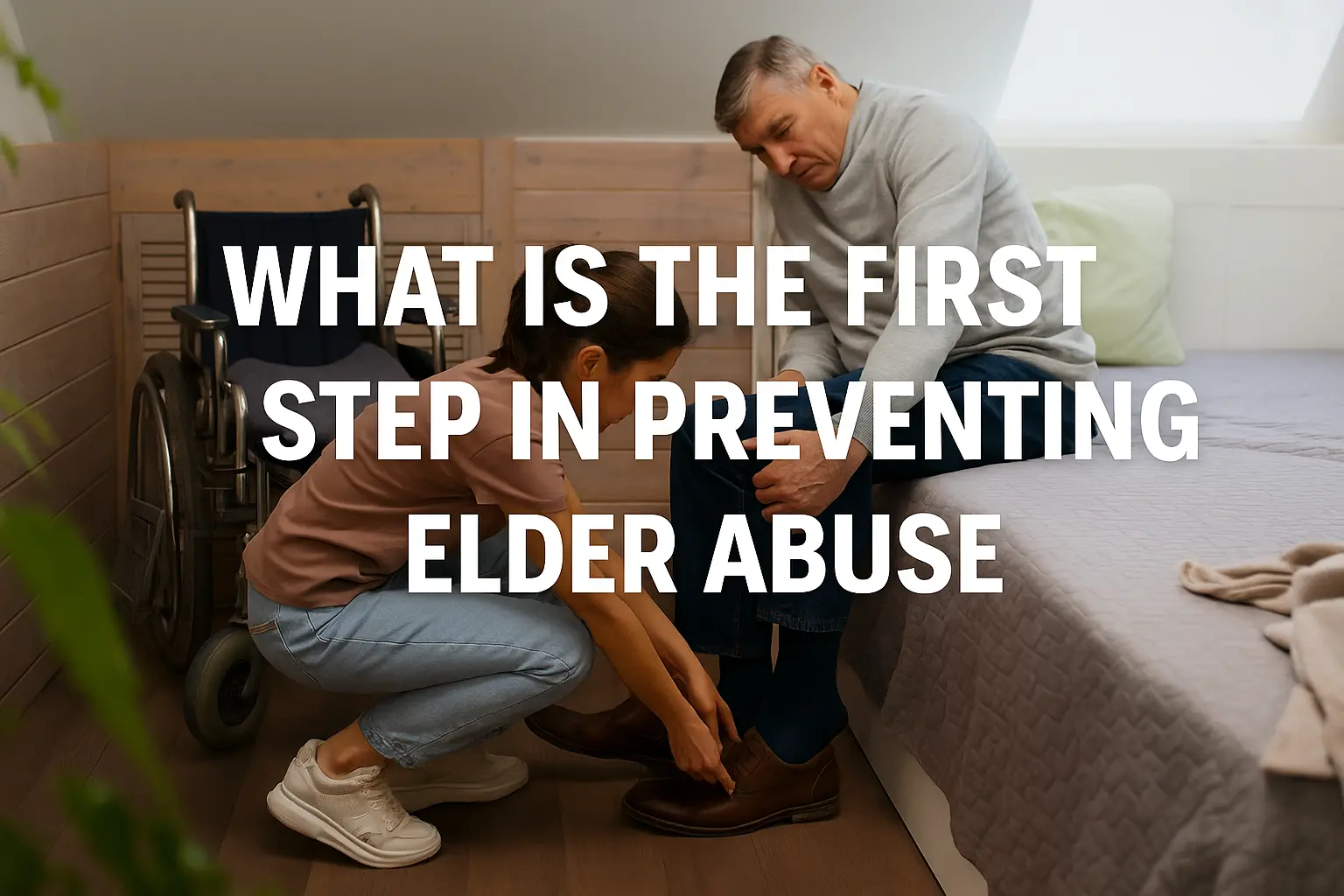What Is the First Step in Preventing Elder Abuse begins with recognizing early warning signs, empowering families and seniors, strengthening oversight in care facilities, and taking swift legal action when necessary. Moran Law’s experienced elder abuse attorneys in California provide the expertise and support needed to protect vulnerable seniors and hold negligent parties accountable.
Table of Contents
What Age Is Considered Elder Abuse
In California, an elder is a person age 65 or older. The law also protects a dependent adult between eighteen and sixty four whose physical or mental limitations restrict daily activities or the ability to safeguard legal rights. These definitions apply in private homes, assisted living, and skilled facilities, and they determine when civil elder abuse protections can be used.
Age opens the door to protection, but vulnerability matters. Cognitive change, mobility limits, chronic illness, and reliance on caregivers can qualify a younger adult as a dependent adult. Courts and agencies consider both status and conduct, asking whether protected status existed and whether neglect, physical abuse, financial exploitation, isolation, or abandonment occurred under the statute.
What Is the First Step in Preventing Elder Abuse is to identify protected status early and act on concerns without delay. Confirm whether the person meets the elder or dependent adult definition, document specific facts and timelines, and route the concern to the proper channel such as facility administration, local adult protective services, or counsel. Early identification preserves evidence, clarifies reporting duties, and helps stop harm before it escalates.
What Is Elder Abuse?
In California, elder abuse means harmful acts or failures of care that place an older adult at risk of injury, fear, or loss. Abuse can be physical force, unwanted sexual contact, verbal threats, humiliation, or coercion. Neglect includes failing to provide food, medication, hygiene, or supervision when a duty to care exists. Financial exploitation covers misuse of money, property, or legal authority. Isolation and abandonment are forms of abuse when they cut a person off from needed support.
Responsibility can rest with family members, hired caregivers, or facility staff and management. Cases also arise when several parties contribute to harm through poor training or unsafe routines. Abuse occurs in nursing homes, assisted living communities, and private homes, and the warning signs differ by setting. In facilities, look for sudden declines, repeated falls, pressure injuries, or unexplained transfers. In private homes, concerns often involve missed medications, unsafe living conditions, or new control over bank accounts.
Prevention begins with early recognition and prompt action. The answer to What Is the First Step in Preventing Elder Abuse is to identify risk, document what happened and when, and report concerns to the proper channel in California. For facilities, that includes the Long Term Care Ombudsman and local authorities. For community cases, Adult Protective Services and local law enforcement can triage safety and coordinate next steps. Clear notes, dates, and names help protect evidence while safety plans are put in place.
Types of Elder Abuse
Understanding the different types of elder abuse is essential when asking the question what is the first step in preventing elder abuse. Identifying specific patterns of mistreatment allows families, caregivers, and legal advocates to intervene early before harm escalates. Elder abuse takes many forms, each with serious consequences that require tailored prevention and legal strategies.
Physical Abuse of Elderly
Physical abuse includes any intentional use of force that causes bodily pain, injury, or discomfort. This may involve pushing, hitting, grabbing, or improperly restraining an elderly person. In licensed care settings, it can also occur when frail residents are left in unsafe environments that increase the risk of harm.
In one case handled by Moran Law, a resident with a known fall risk was left alone near a parking area outside an assisted living facility. Attempting to avoid a moving vehicle, the resident fell and suffered a fatal brain injury. This situation demonstrates how lack of supervision and disregard for safety precautions can lead to devastating outcomes that legally qualify as physical abuse.
Emotional and Psychological Abuse
Emotional abuse affects an elder’s mental wellbeing through persistent verbal attacks, manipulation, threats, or isolation. It may not leave visible injuries, but it often leads to severe emotional distress, withdrawal, confusion, or depression.
Caregivers who ignore emotional needs, mock residents, or threaten them for compliance contribute to a pattern of psychological harm. When elders are intentionally made to feel worthless, scared, or alone, this form of abuse can become as damaging as physical mistreatment. Recognizing the signs early is critical to prevention.
Financial Exploitation
Financial exploitation involves the unauthorized or deceptive use of an elder’s assets, bank accounts, or personal property. It includes forging signatures, pressuring elders to modify wills, or stealing valuables and benefits.
This abuse often occurs in care facilities when staff gain access to residents’ checks, debit cards, or online accounts. In other cases, family members misuse power of attorney for personal gain. Preventing financial exploitation begins with oversight, transparency, and legal safeguards that protect the elder’s financial autonomy.
Neglect and Abandonment
Neglect happens when a caregiver fails to provide necessary support such as food, hygiene, supervision, medication, or medical treatment. Abandonment occurs when a caregiver deserts an elder who cannot care for themselves.
Several high-profile cases managed by Moran Law reflect these patterns. In one case, a resident was left in a bathroom unattended, fell, and died from a brain injury. In another, a resident with diabetes did not receive essential insulin, resulting in fatal complications. These events were not isolated mistakes but failures to provide the most basic care—actions that fall under legal definitions of neglect.
Neglect is often unintentional but results from poor staffing, lack of training, or disregard for health protocols. Prevention begins with accountability, regular welfare checks, and family involvement in care planning.
Sexual Abuse
Sexual abuse involves any unwanted sexual contact or behavior directed at an elderly person without consent. This includes inappropriate touching, sexual assault, or being forced to watch or participate in sexual acts.
Elders with cognitive impairments such as dementia are particularly vulnerable, as they may be unable to communicate what happened. In care facilities, abuse often occurs in private settings with minimal oversight. Warning signs may include unexplained injuries, infections, or sudden behavioral changes.
Sexual abuse is one of the most underreported forms due to shame, fear, or lack of awareness. Preventing it starts with vigilant supervision, staff screening, and open communication with the elder about safety and comfort.
How to Prevent Elder Abuse
Preventing elder abuse begins with proactive vigilance and community involvement. What is the first step in preventing elder abuse? It is the early recognition of patterns and behaviors that may indicate mistreatment. While legal remedies are available after abuse occurs, prevention depends on families, caregivers, healthcare professionals, and facility staff working in collaboration to create safe, respectful environments for aging individuals. The following preventive measures outline a multi-layered approach to safeguarding seniors across California.
Recognizing the Early Warning Signs
The first and most critical step in preventing elder abuse is the ability to identify subtle changes that suggest harm. Warning signs may include unexplained bruises, sudden mood shifts, withdrawal from activities, hesitancy around caregivers, missed medications, or irregular financial transactions. Seniors in California’s care facilities who exhibit these signs may be at risk for various types of abuse, including physical harm, emotional distress, or financial exploitation. Early recognition allows families or mandated reporters to intervene before the situation worsens.
Building Awareness Among Family and Caregivers
Families and private caregivers play a key role in prevention. Educating them about the forms of elder abuse and equipping them with tools to monitor behavior, living conditions, and communication patterns can reduce the likelihood of mistreatment. Holding regular discussions about dignity, safety, and personal autonomy helps reinforce expectations of respectful care. When families understand the laws protecting seniors in California, they are more likely to question facility practices or speak up if something feels wrong.
Educating Staff in Care Facilities
Facilities must ensure all staff receive thorough and recurring training on recognizing, preventing, and reporting abuse. This includes understanding the legal responsibilities imposed by California’s Elder Abuse and Dependent Adult Civil Protection Act. Staff should be trained not only in physical care but also in emotional support, resident rights, and communication with nonverbal or cognitively impaired seniors. Institutions that prioritize education reduce the risk of abuse and improve their overall standard of care.
Empowering Seniors to Speak Up
Many elderly individuals hesitate to report mistreatment due to fear of retaliation or the belief that they will not be believed. Empowering seniors means affirming their right to safety and encouraging open dialogue about their daily experiences. Providing access to communication tools, private meetings with advocates, and reassurance that their voice matters fosters confidence and autonomy. When older adults feel supported, they are more likely to disclose discomfort or abuse.
Reviewing Facility Safety and Staffing Levels
Families placing loved ones in assisted living or nursing homes should carefully assess each facility’s safety protocols and staff-to-resident ratios. Chronic understaffing often leads to neglect, medication errors, and delayed responses to emergencies. Evaluating a facility’s past violations, inspection reports, and employee turnover rates can provide insight into potential risks. California facilities are required to meet specific regulatory standards, and informed families are better positioned to hold them accountable.
Financial Monitoring and Legal Safeguards
Financial exploitation is one of the most overlooked forms of elder abuse. To prevent it, families should implement checks and balances, such as joint bank accounts, regular reviews of financial activity, and the appointment of trustworthy powers of attorney. Legal safeguards, including advance directives, conservatorships, and clear estate planning, can help ensure decisions are made in the elder’s best interest. Regular oversight by financial professionals or family members adds an additional layer of protection.
Reporting Concerns Early to Authorities or a Lawyer
Timely reporting is essential. Suspected abuse should be brought to the attention of Adult Protective Services, the California Department of Public Health, or local law enforcement. Delays can result in irreversible harm. For families seeking both protection and legal accountability, working with experienced elder abuse attorneys such as the team at Moran Law ensures that reports are thoroughly investigated and justice is actively pursued. Whether the abuse takes place in a nursing home, assisted living facility, or private residence, swift legal action can stop ongoing harm and help prevent future incidents.
Contact Moran Law — Experienced Elder Abuse Attorneys in California
What is the first step in preventing elder abuse? It starts with speaking up. Families who suspect neglect or mistreatment often feel overwhelmed or unsure of what to do next. Moran Law provides clear guidance and legal representation to help protect elderly loved ones from further harm. Moran Law has successfully represented victims in nursing homes, assisted living facilities, and other care environments across California. Their team understands how to investigate suspicious injuries, delayed medical care, unexplained weight loss, pressure ulcers, and other signs that may indicate abuse or neglect.
Whether a case involves physical harm, emotional trauma, financial exploitation, or inadequate medical attention, Moran Law offers compassionate legal support and aggressive advocacy. Consultations are free, and cases are handled on a contingency basis, meaning there are no fees unless a recovery is made.
Families can take the first step toward protecting their loved ones by contacting Moran Law directly through their website or calling their California office. The sooner legal action begins, the greater the chance of preventing further abuse and holding negligent parties accountable.


